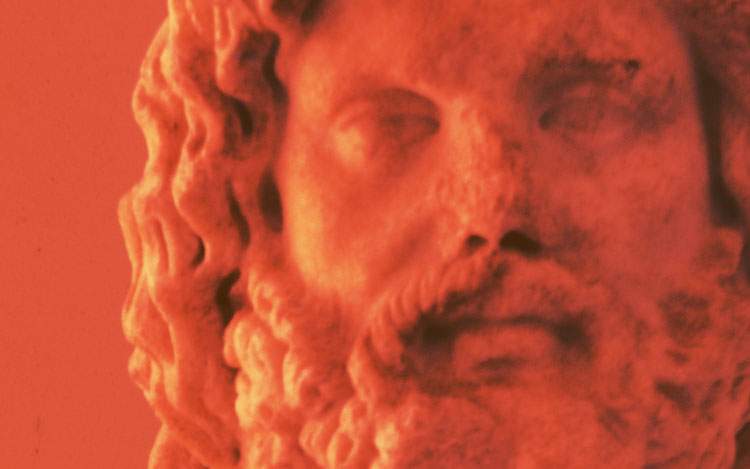The National Roman Museum, in its headquarters at Palazzo Altemps, is hosting from October 2 to November 1 the photographic exhibition Statuae Vivae, a project by Sergio Visciano (Verona, 1969) curated by Paola Riccardi. It is an exhibition on classical statuary that aims to recount myth, memory and culture through a contemporary gaze: the review consists of twenty-three images that interpret some masterpieces of classical art belonging to the collections of the National Roman Museum, but also of the Capitoline Museums, the National Archaeological Museum of Naples, the Archaeological Museum of the Phlegraean Fields in the Castle of Baia and Palazzo Mattei di Giove in Rome. The project was among the winners of the expression of interest launched by the National Roman Museum in March 2020, as part of the Archaeology and Photography project, with the aim of raising awareness of Italian and foreign archaeological heritage through the language of photography.
A photographic journey, between past and present, that was born several years ago: the first body of work, begun between 2006 and 2007, was carried out between Rome, Naples and Baia. This led to a first nucleus of works that were exhibited in 2011 at the Reggia di Colorno, as part of the ColornoPhotolife Festival. Then, in 2018, the project was hosted by the Archaeological Museum of the Phlegraean Fields in the castle of Baia, in whose setting it was inserted, with a site-specific installation both inside and in the external loggias. The photographic series stems from the idea of enhancing the classical statuary present in the most important archaeological museums in the national territory, an integral part of the collective imagination about antiquity, beauty, classicism. With the intention of creating a strong connection between the work of art and the viewer, the goal is to enhance the essence of the statuary and its message, which goes beyond the time and historical context in which it was made.
Taking a cue from the Mediterranean series of the famous photographer Mimmo Jodice, in Statue Vivae Sergio Visciano observes the light that in the different hours of the day strikes the statues and, using a technique of blurring in the shot and a subsequent digital reworking, he makes his photos. He works, in particular, on the addition of chromatic elements, creating depictions in which color becomes an expressive sign. The photographer’s observation of the sculptures emphasizes a particular gesture, a movement, a look, with the ultimate goal of making the work “come alive.”
"Sergio Visciano’s Statuae Vivae exhibition inaugurates the first photographic exhibition of the Archaeology and Photography project of the National Roman Museum," stresses director Stéphane Verger. “The project was created to promote archaeological heritage through the universal language of photography. In addition, the link between the works and the images allows to strengthen the relationship that exists between the Museum, the territory in which it is located and contemporary creativity. The exhibition finds, therefore, in the venue of Palazzo Altemps the ideal setting for a visual narrative dedicated to ancient sculpture, placing itself in constant dialogue with the works of the noble collections preserved here.”
“The different colors I used are meant to emphasize the ’spirit’ of each statue, to enhance its strength or gentleness, seductiveness or timidity,” explains Sergio Visciano. “The sculptures of the Olympian gods, in addition to beauty, tell the myth and history of the West, so I was fascinated by them and found it necessary to capture them with my photographic lens and then rework the images in a contemporary key. These myths, these gods, are still among us, and they are part of us, part of our history.” Images of the past and classicism are thus reinterpreted in a contemporary key and set up in the temporary exhibition hall on the second floor of the National Roman Museum at Palazzo Altemps. The twenty-three images are framed by large iron structures of triangular module, thus aspiring to create an interplay of perspectives and suggestions. The arrangement of the images allows the visitor time and space for reflection, also aiming at the surprise effect in discovering the images of myth brought to life by the photographer’s eye. "With Statuae Vivae,“ says curator Paola Riccardi, ”Sergio Visciano reinterprets classical sculpture and, with the addition of color and movement, brings to life pulsating characters that transcend classicism to become universal and moral content."
Sergio Visciano was born in Verona in 1969. He is a geologist and since his university studies has participated in some important archaeological excavations in the Padua area. He became passionate and specialized in photography and from 2012 to 2016 he shared a studio with the artist photographer Mauro Fiorese. In 2012 he attends a course for Curator of contemporary art events at the A+A gallery in Venice, which allows him to study the major contemporary art movements. He exhibits his works at some important Italian spaces and museums including Spazio Lattuada, Reggia di Colorno, Made 4 Art Gallery, Archaeological Museum of the Phlegraean Fields in the Castle of Baia. He published in 2012 the book “La Divina Commedia per Immagini” for Edizioni Valdonega.
The exhibition can be visited during the opening hours of the National Roman Museum: Tuesday to Friday from 2 p.m. to 7:45 p.m., Saturday and Sunday from 10:30 a.m. to 7:45 p.m. For info visit the website of the National Roman Museum.
 |
| Statuae Vivae: at the National Roman Museum, Sergio Visciano rereads ancient sculptures |
Warning: the translation into English of the original Italian article was created using automatic tools. We undertake to review all articles, but we do not guarantee the total absence of inaccuracies in the translation due to the program. You can find the original by clicking on the ITA button. If you find any mistake,please contact us.